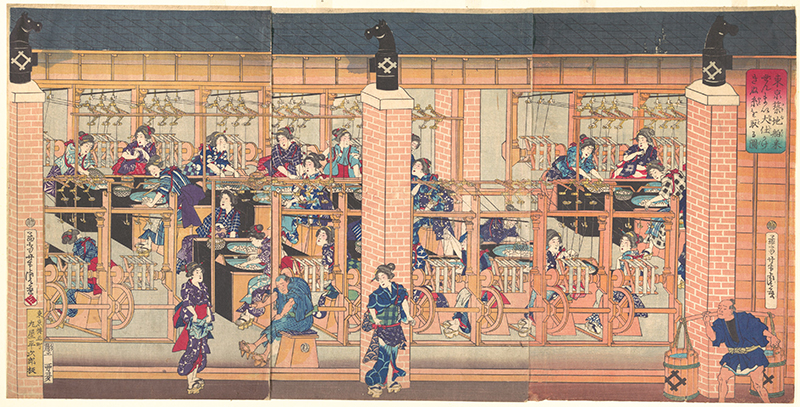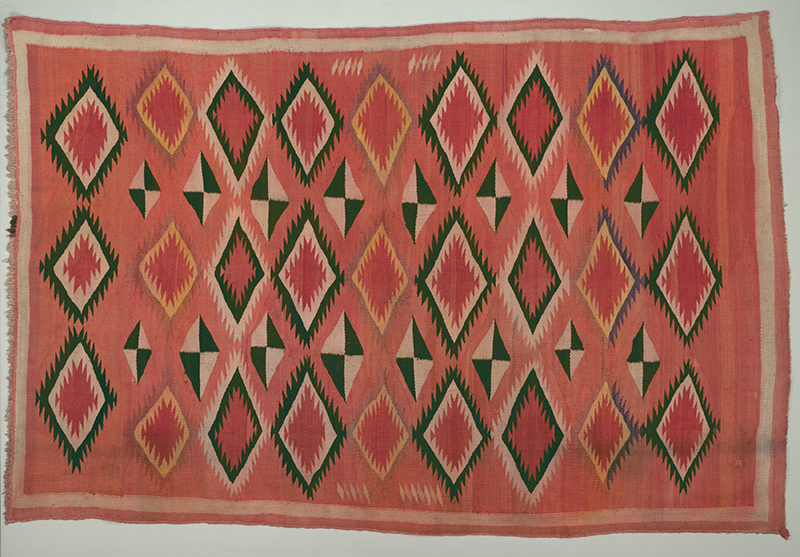The Fibers that Bind: A New “People’s History of Clothing”
by Kate Burnett Budzyn
 It’s been a long time since I’ve been as surprised by a book as I was by Sofi Thanhauser’s Worn: A People’s History of Clothing. As the book review editor at Winterthur Portfolio, I skim through dozens of new material culture publications each month, delighting in the specificities that are the field’s bread and butter. It is both soothing and endlessly edifying to be part of an academic world that supports the in-depth study of menthol cigarettes, art deco bedrooms, and tchotchkes. Material culture scholars prove over and over again that little things can carry big weight. I’ve come to think of this as a radically microscopic way of going about history-making—slow history, if you will.
It’s been a long time since I’ve been as surprised by a book as I was by Sofi Thanhauser’s Worn: A People’s History of Clothing. As the book review editor at Winterthur Portfolio, I skim through dozens of new material culture publications each month, delighting in the specificities that are the field’s bread and butter. It is both soothing and endlessly edifying to be part of an academic world that supports the in-depth study of menthol cigarettes, art deco bedrooms, and tchotchkes. Material culture scholars prove over and over again that little things can carry big weight. I’ve come to think of this as a radically microscopic way of going about history-making—slow history, if you will.
Thanhauser’s peripatetic exploration of the way clothes are made is indeed a work of material culture, but it bypasses the close, focused study that is more typical of the field. This is a huge and messy history of the huge and messy processes by which humans have produced their clothing since the Paleolithic Age. While Thanhauser, who teaches writing at Pratt, brings particular attention to America’s role within the global clothing industry, her book is without boundaries. The author draws extensively from others’ histories of international textile industries but then visits many present-day agricultural and industrial sites herself—from Texas cotton farms to silk filatures in the Yangtze River Delta—describing the people she meets and their surroundings in the first-person.
An 1872 print by Utagawa Yoshitora offers a detailed illustration of 19th-century silk manufacture, a process discussed at length in “Worn.” Here, female workers at Ono Silk Filature Company in Tokyo are shown emptying baskets of silk moth cocoons into vats of steaming water and reeling the cocoons’ thread ends onto a spinning frame. Utagawa Yoshitora, Imported Silk Reeling Machine at Tsukiji in Tokyo, 4th month, Japan. Triptych of woodblock prints, ink and color on paper. The Metropolitan Museum of Art, Gift of Lincoln Kirstein, 1959, JP3346.
The author corrals her multimodal research into five sections, each tackling one of the main fiber types that constitute clothing. Linen is the oldest fiber in the archaeological record. Thanhauser uses it to examine women’s historical and lasting centrality in the production of cloth and to consider the ways in which their labor has been valued and devalued over time. Cotton is “an incredibly thirsty crop,” whose cultivation has consistently violated the land and the people who grow it. The author establishes breathtaking links between the US decline in cotton production around the time of the Civil War—when the world could no longer rely on American enslaved laborers to produce it cheaply—and the rise of British investment in cotton farming in India. This new imperial emphasis on cotton cultivation would disrupt a centuries-old tradition of cotton weaving and printing.
The vulcanization process that allowed rubber to be introduced into the clothing industry in the 1850s relied on carbon disulfide, the same neurotoxic chemical used to produce rayon in the 20th century (Thanhauser, 159). Meyer Rubber Company, Galoshes, c. 1886, United States. Brooklyn Museum Costume Collection at The Metropolitan Museum of Art, Gift of the Brooklyn Museum, 2009, Gift of C. Otto von Kienbusch, 1971, 2009.300.3352a,b.
Silk is the product of an ancient Chinese industry now on the brink of extinction. Synthetics, since their mid-19th-century dawn, have exposed workers to neurotoxins and, as a result, were the source of modern labor movements. Wool comes last in the book because it is the fiber that Thanhauser sees as a source of hope within a global system that seems doomed by ever-growing demand to perpetuate ever-greater levels of violence against workers and earth alike. Exploring small communities that engage in sheep-rearing, spinning, knitting, and weaving—including attendees of Cumbria’s Woolfest and members of the contemporary Navajo Nation—she finds that people who make cloth from wool on a local scale enjoy an experience that is profoundly human, and yet nowadays rare: producing something from start to finish while caring for land, animals, and people in a way that can be passed down to future generations.
Sometimes Worn’s five fiber categories are too clear-cut to hold the complexities that Thanhauser is interested in. A chapter offering a quick survey of fashion history is shoehorned into “Silk” because of that fiber’s metonymic link with luxury and sophistication, but of course fashion cuts across all fiber (and other material) types. Such imperfect boundaries point to the fact that Thanhauser isn’t really interested in the subtleties of dress history.
In the late 19th century, following a brutal period of internment at Bosque Redondo by the US government, Navajo weavers began introducing brilliantly dyed yarns into their weavings. Predominantly made in Germantown, Philadelphia, the yarns were artificially colored using aniline dyes. Navajo weavings of this “transitional period” are recognized for their explosive use of color and great stylistic innovation (Thanhauser, 275). Rug (Woman’s Wearing Blanket Style), 1895–1905. Handspun wool. The Cleveland Museum of Art, Gift of J.H. Wade, 1921.563.
The book does not, as the title suggests, dwell on the details of clothing itself—there’s no reveling in close-looking at garments as objects. To my initial horror, it has no illustrations. As I became immersed in the text, however, I found this lack of images strangely revelatory—I could simply look up images online as needed. This is a people’s history, and the people are capable of finding out more about the things that pique their interests. In place of neat thesis or tidy parameters, Thanhauser attempts something truly grand: a stab at the whole of clothing, an investigation of the industrial cosmos that has clothed humans. What is lost in focus is gained in a sense that history is always, necessarily, crowdsourced. Just as our purchase of a single piece of cotton underwear today might likely link us materially, environmentally, and ethically to the forced labor of Uyghur workers in Xinjiang, our encounter with one work of history puts us in contact with dozens if not hundreds of others.
Thanhauser zooms in regularly to offer dense little histories of particular moments before zooming back out, scanning for larger themes, and casting a thread of connection to another point in time. She skips easily from a history of DuPont nylons to tours of export processing zones in Vietnam and Honduras, from Rose Schneiderman’s early 20th-century “bread and roses” labor movement to postwar Japanese cotton manufacture. It’s a distinctly internet-reminiscent way of structuring a history: find a point of inquiry, jump down the rabbit hole for a minute or two, and then find another. It’s also evocative of web-making, which—as the author herself explains in an eloquent conclusion—has for millennia been used across cultures as a symbol of weaving and textile manufacture.
“It can be tempting,” Thanhauser writes, “to rely on notions of ‘globalization’ that normalize the fiction that the origins of objects are simply too complex to understand.” Worn refuses the temptation of small-scale materiality and connects us to a vast and compelling web of complexities.
Kate Burnett Budzyn is a contributing writer for The Decorative Arts Trust Bulletin. She researches historic clothing and textiles and is the book review editor at Winterthur Portfolio.
About The Decorative Arts Trust Bulletin
Formerly known as the "blog,” the Bulletin features new research and scholarship, travelogues, book reviews, and museum and gallery exhibitions. The Bulletin complements The Magazine of the Decorative Arts Trust, our biannual members publication.










